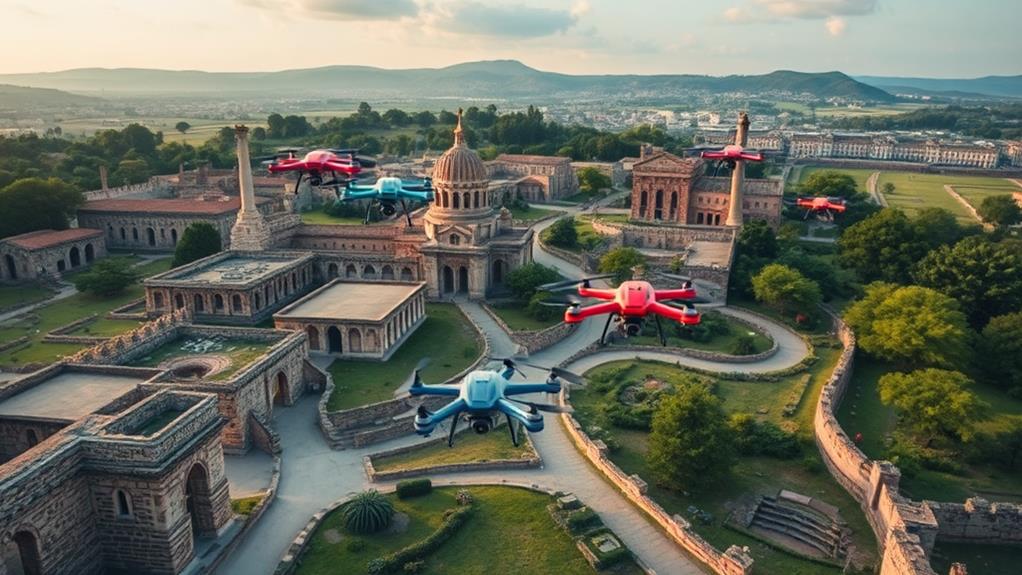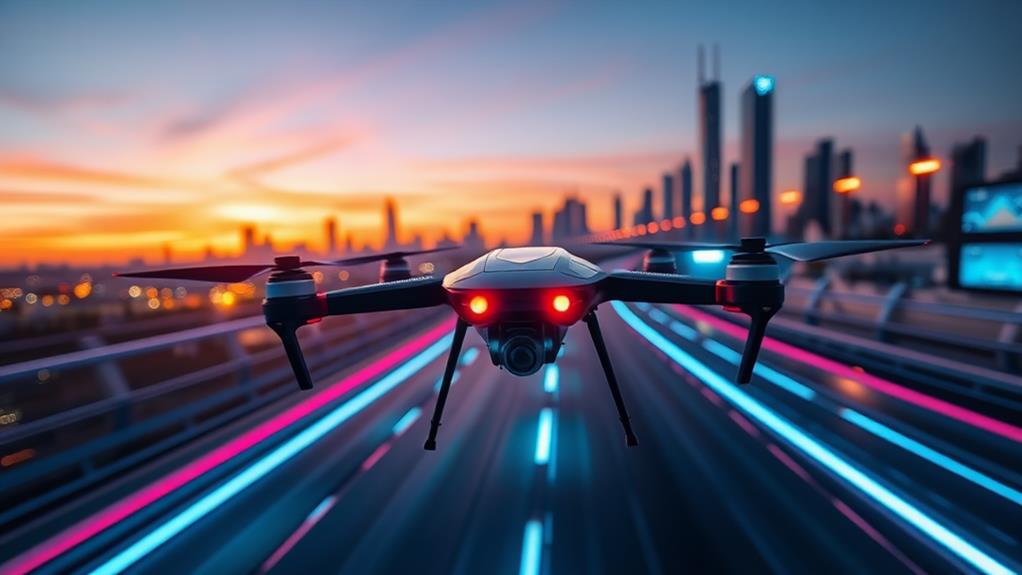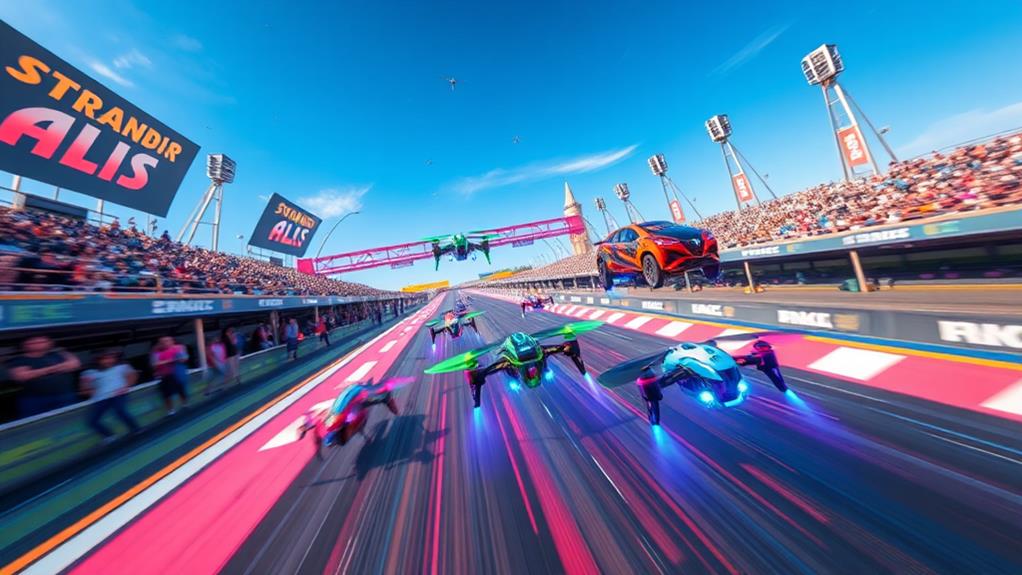Exploring the Drone Racing Championship Series reveals a thrilling world of high-speed competitions. This sport gained momentum in the early 2010s, with the Drone Racing League (DRL) being established in 2015. Events like the upcoming U.S. Air Force Miami Invitational in 2025 promise to feature elite pilots racing at speeds over 90 mph through intricate courses. With advancements in technology, like AI and 5G connectivity, both pilots and spectators enjoy an enhanced experience. As young, tech-savvy audiences increasingly engage with the sport, drone racing's future looks bright. There's much more about these innovations and events that you'll find intriguing.
History of Drone Racing

Drone racing has quickly evolved into a thrilling competitive sport since its inception in the early 2010s. This exhilarating activity gained traction through online streaming and social media, enchanting audiences worldwide.
In 2015, the establishment of the Drone Racing League (DRL) marked a significant milestone, as it became the first official racing league dedicated to this emerging sport. The DRL has since led the charge in promoting professional drone racing and organizing high-profile events, including the DCL World Championships that showcase elite racers.
Competitions typically feature pilots steering high-speed drones through intricate courses filled with gates and obstacles, testing their skill and precision. As technology advanced, drone racing incorporated cutting-edge innovations, including autonomous systems like Swift, which can compete alongside human pilots at champion-level performance.
The sport's popularity surged even further in 2020 when the DRL launched the DRL Allianz World Championship, expanding its global reach and showcasing drone racing on an international stage.
As you follow the development of this competitive sport, you'll appreciate how drone racing has transformed into a well-structured environment where enthusiasts and professionals can thrive and compete at the highest levels.
Key Competitions and Events
In 2025, the DRL U.S. Air Force Miami Invitational is set to be a key event in the Drone Racing Championship Series. This championship event will feature twelve top pilots racing through a high-speed aerial course, showcasing drones that can exceed speeds of 90 mph.
As you watch, you'll see competitors navigate complex elements like hairpin turns and vertical climbs, which truly tests their skills. The event not only highlights the thrilling nature of drone racing but also emphasizes the role of emerging talent in shaping the future of the sport.
The DRL, or Drone Racing League, aims to connect with tech-savvy youth, promoting STEM careers through exciting competitions. By partnering with the U.S. Air Force, they're not just racing; they're merging sports entertainment with technological innovation.
Expect immersive technology to enhance your spectator experience, making it more engaging than ever.
This Miami Invitational marks the first major competition following DRL's acquisition by Infinite Reality, setting the stage for future advancements in drone racing and technology integration.
You'll witness how the Drone Racing Leagues are evolving, pushing boundaries and inspiring the next generation of pilots. Don't miss this thrilling event where the best pilots race, demonstrating incredible talent and cutting-edge technology in the world of drone racing.
The Role of Technology

As the excitement of the DRL U.S. Air Force Miami Invitational builds, technology takes center stage, transforming drone racing into a showcase of advanced capabilities. This event highlights how innovation drives the sport forward, integrating cutting-edge technologies like AI, spatial computing, and extended reality to enhance the spectator experience.
You'll witness firsthand how these advancements redefine competitive racing, with features such as 5G connectivity enabling faster data transfer for real-time communication. Autonomous systems, such as the impressive Swift, demonstrate the power of technology in this arena. Swift utilizes Visual Inertial Odometry (VIO) and neural networks, allowing it to navigate complex courses with precision, often outperforming human pilots. By maintaining tighter trajectories and executing intricate maneuvers at high speeds, Swift sets a new standard for performance in drone racing.
The bespoke aerial course at the event is designed to challenge pilots and their technology, highlighting the synergy between skill and advanced technological support.
This partnership with the U.S. Air Force also aims to inspire the next generation of engineers and pilots, emphasizing the significant impact of technology in sports and the career opportunities it creates in STEM fields. Through these examples, it's clear that innovation is reshaping the future of drone racing.
Pilots and Their Skills
Eleven skilled pilots take to the skies in the DRL U.S. Air Force Miami Invitational, showcasing their incredible talents in drone racing. Each pilot, including two-time World Champion Evan Turner, navigates complex aerial courses at speeds exceeding 90 mph.
These drone pilots must possess exceptional hand-eye coordination to maneuver their drones through intricate track elements like hairpin turns and vertical climbs.
To excel in this high-stakes environment, pilots rely on live video feeds from their drones, allowing them to make real-time adjustments as they race. Quick decision-making is essential, as conditions can change rapidly during a race.
Beyond technical flying skills, strategic planning plays a significant role in achieving success. Pilots must assess the course layout and anticipate their opponents' moves, making split-second choices that can determine the outcome.
These attributes not only highlight the level of skill required but also the intense competition present in the Drone Racing League. As you watch these pilots in action, it's clear that their dedication, practice, and honed abilities set them apart in this thrilling sport.
Future of Drone Racing

Embracing cutting-edge technology, the future of drone racing promises to captivate audiences like never before. As the sport evolves, several key factors will shape its trajectory:
- Competitive Format: Events like the DRL U.S. Air Force Miami Invitational will feature intense competitions, showcasing twelve high-speed pilots maneuvering challenging aerial courses.
- Autonomous Technology: With drones like Swift consistently outperforming human pilots, the integration of autonomous systems will redefine how we perceive competition in drone racing.
- Immersive Technologies: Expect thrilling spectator experiences through AI and extended reality, creating an atmosphere akin to a real-life video game, enhancing engagement.
- Performance Advancements: Drones capable of exceeding speeds of 90 mph will push the limits of performance, ensuring each race is more exhilarating than the last.
This combination of innovation and excitement will attract a younger, tech-savvy audience, solidifying drone racing's place in the sports entertainment landscape.
As these elements converge, you can look forward to a future where drone racing isn't just a sport but an immersive experience that blurs the lines between reality and virtual competition.
Conclusion
As you dive deeper into the world of drone racing, you'll discover it's not just a sport; it's a thrilling blend of technology, skill, and competition. With advancements on the horizon and pilots honing their craft, the future holds exciting possibilities. What challenges await the next generation of racers? How will technology evolve to shape the sport? Stay tuned, because the high-speed chase of drone racing is just getting started, and you won't want to miss what's next.

Leave a Reply